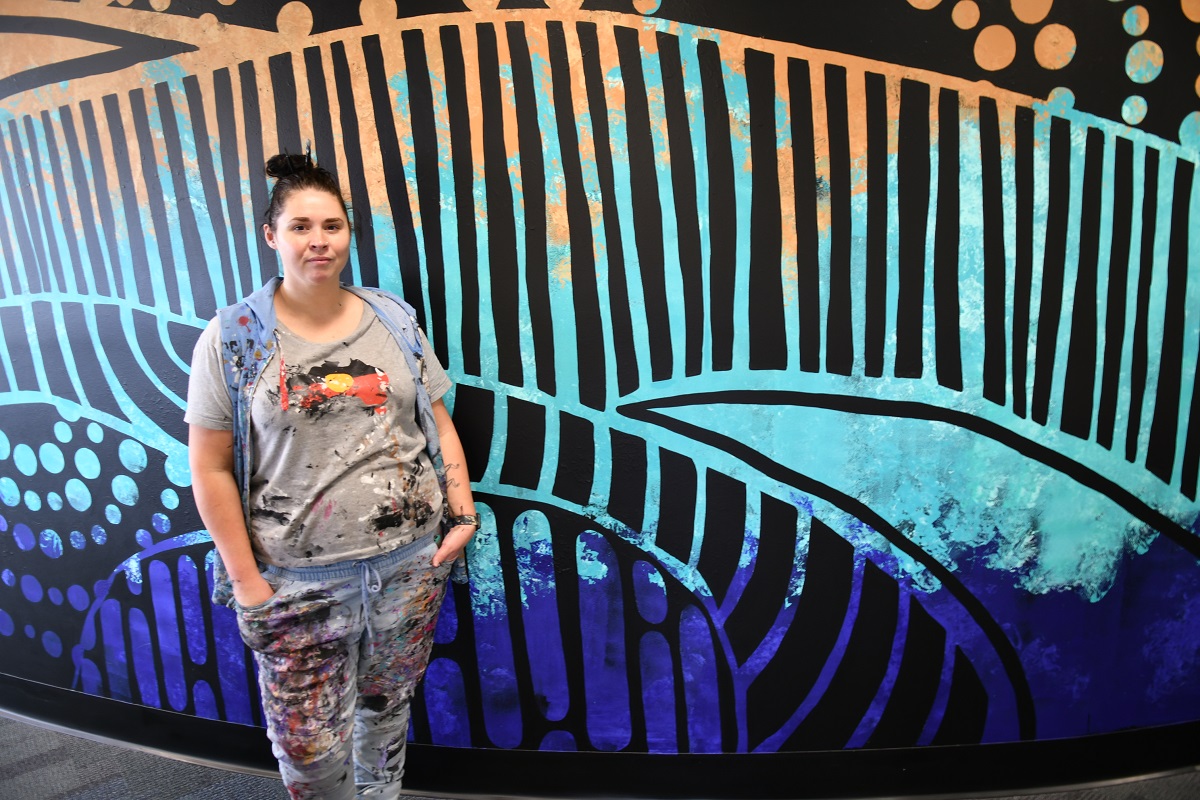
Students returning to Flinders University’s Yunggorendi Tjilbruke student lounge this semester will be welcomed by a surge of colour and a fresh sense of belonging, thanks to a magnificent new mural.
In vibrant blue, teal and ochre on bold black, the diversely textured work flowing over its internal walls is the latest addition to Flinders University’s visual splendour. Building on the hand-painted tiles outside the Indigenous centre which feature in the University’s Innovate Reconciliation Action Plan, the rich collections of the Flinders University Museum of Art and numerous creations around campus, the mural complements the University’s stunning natural environment and views.
The artwork is the creation of contemporary Aboriginal artist Elizabeth Close, a Pitjantjatjara Yankunytjatjara woman and Flinders alumna, who graduated from the University with a Bachelor of Nursing in 2011.
Last year Ms Close painted a mural at Sturt to welcome visitors to the campus and its Flinders2Go clinic. The Yunggorendi mural borrows its rich colours, which reflect the sea, sky and the university’s unique landscape – infusing guests with a sense of energy and belonging.
“We wanted the artist to speak to the importance of belonging and community, and to visualise their story and journey into higher education from an Indigenous perspective,” says Pro Vice-Chancellor Indigenous, Associate Professor Simone Ulalka Tur.
The Tjilbuke Lounge will also refresh two of its offices to support Aboriginal and Torres Strait Islander students’ academic engagement and wellbeing, and to connect students with an Elder-On-Campus and cultural advisor, soon to be appointed.
These spaces will include capturing natural light through glass walls to the new mural and bring prominence and relationality to Indigenous senior knowledge holders.
“We have Aboriginal and Torres Strait Islander students who come to Yunggorendi Mande from many communities around the country, and we want all students to feel welcome. We needed to give the artist the freedom to achieve that in a way that would reflect this diversity.” Associate Professor Tur explains.
The project was managed by Ochre Dawn Creative Industries, who liaised with Flinders, the artist and other suppliers who manufactured the pillar vinyls and signage.
Ms Close says the organic, flowing walls invited a narrative wrapped around the concepts of journey.
“This is a space where students from all corners of the continent and the Islands come together,” she says.
“Their journeys are all different and not linear. Yet there is a sameness across them all, which is the desire to come here and learn and take that knowledge back.”
Ms Close frequently uses colour to speak to country and form to discuss narrative, a method she has employed in this design.
“The view of the coast and sky is magnificent in this space, so I wanted to honour that through the pallet. The texture speaks to the landscape including the undulations of the coastline, together with the different lands of the people who use this area.”
The circles in the kitchen represent the concept of community; the curves across the doors reflect students on a common journey of learning; the large curved wall honours where students have come from and where they are going.
“It is very much landscape based,” Ms Close explains. “As a Pitjantjatjara Yankunytjatjara woman I couldn’t sit here on Kaurna country and tell their stories, nor could I tell my own stories on Kaurna land. What I can do, is speak broadly to that connection to country we all share.
“This had to represent everyone, it has to speak to all the students who come here.
The variations in pattern reflect the many different places students have come from – rolling hills to coastal communities or rocky landscapes across the nation.
In recent years Ms Close has immersed herself deeper in public art, though she continues to create 2D studio works. Her murals have taken her around the country and the world, with a commission in Melbourne currently on hold as the pandemic continues.
“I love public art. I love its accessibility. It takes art out of the galleries and puts it where everyone can access and enjoy it,” she says.
From practising as a registered nurse to gaining entry to medicine at Flinders after years of trying, Ms Close’s own journey is diverse – but it’s difficult to see her moving on from art.
“Art was not my best subject at school, I didn’t conform to the expectations of what and how we should be drawing.
“I started my practice later, painting and drawing with my grandmother while learning about our culture. After her death, I became very depressed and returned to what we shared as a way of processing my grief.
“Painting helped me to heal. It’s a way of continuing her knowledge which I felt had gone with her passing.”

